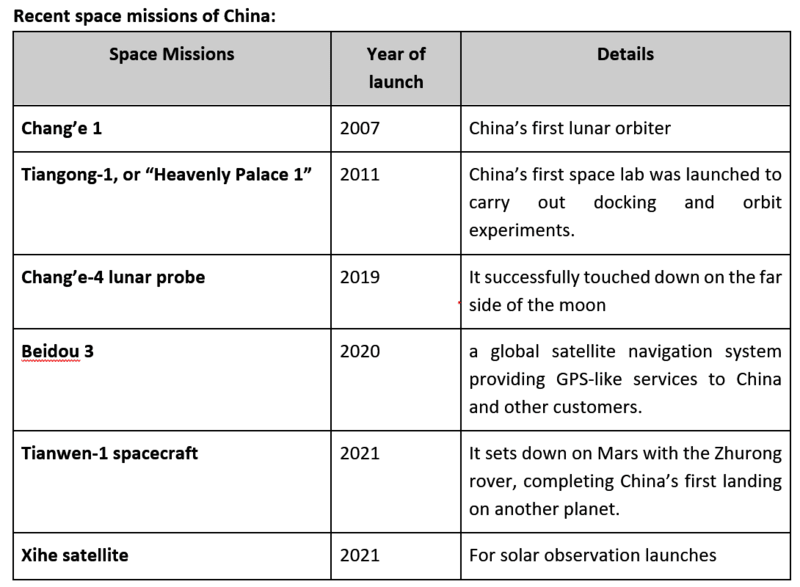Climate impact of plastic pollution
Relevance: GS III (Environment; Pollution)
Why in news?
The production of new plastics, which already account for 4.5% of global emissions, is expected to increase.
Plastic and increasing pollution:
- Plastic pollution and climate change are often linked together, however, according to new research; existing plastic pollution has a negligible impact on carbon emissions. The main concern is the production of new plastics, which already account for 4.5% of global emissions and are expected to increase.
- The leaching of organic carbon from plastic pollution does not significantly affect global carbon cycling or atmospheric CO2 levels.
- Incineration (the process of burning) of plastic waste also has a minimal impact on atmospheric CO2.
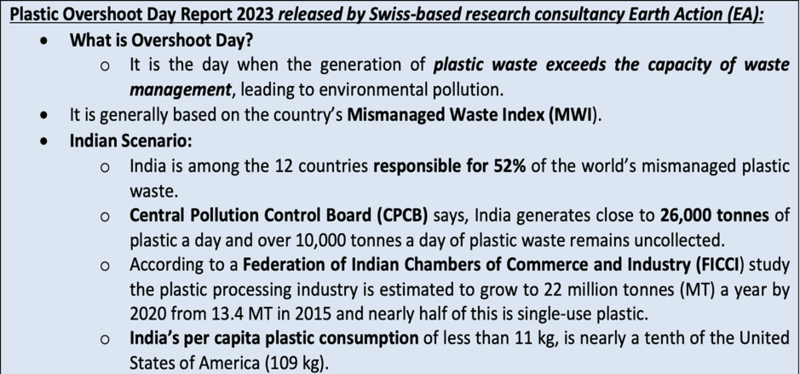
Impacts of Plastic Pollution
- Environment Impacts: Plastic wastes have profoundly affected animals in aquatic, marine, and terrestrial ecosystems.
- Land Pollution: Plastics leach hazardous chemicals onto land, resulting in the destruction and decline in quality of the earth’s land surfaces in terms of use, landscape and ability to support life forms.
- Air Pollution:Plastic burning releases poisonous chemicals into the atmosphere impacting general well-being and causing respiratory disorders in living beings.
- Water Pollution: In 2014, a United Nations report estimated the annual impact of plastic pollution on oceans at US$ 13 billion. Whenever plastics are dumped in landfills, the hazardous chemicals present in them seep underground when it rains. The leaching chemicals and toxic elements infiltrate into the aquifers and water table, indirectly affecting groundwater quality.
- Interference with the Food Chain: When the smaller animals (planktons, molluscs, worms, fishes, insects, and amphibians) are intoxicated by ingesting plastic, they are passed on to the larger animals disrupting the interrelated connections within the food chain.
- Impact on Human Health:The chemicals leached from the plastics contain compounds, like polybrominated diphenyl ether (anti-androgen), bisphenol A (mimics the natural female hormone estrogen) and phthalates (also known as anti-androgens), which impact human health leading to various hormonal and genetic disorders.
- Economic Impacts:Plastic waste along the shoreline has a negative impact on tourism revenue (creates an aesthetic issue). For example, the Andaman and Nicobar Islands are facing aesthetic issues because of the international dumping of plastic waste on the island.
Challenges:
- Higher demand and consumption of Plastic in India: India is the second-largest consumer of plastic globally, with packaging materials contributing significantly to the plastic waste generated.
- Flawed plastic waste management and system: India ranks fourth in the Mismanaged Waste Index (MWI), with 98.55 per cent of generated waste being mismanaged and fares poorly in the management of plastics waste.
- Expected mismanaged waste in future will be 7,300,752 tonnes of plastic. India will also be responsible for releasing an average of 3,30,764 tonnes of microplastics into waterways.
- Municipal authorities are responsible for the collection and transportation of waste, while the waste’s final disposal is usually left to informal waste pickers or landfill sites.
- Waste management is primarily focused on the collection and transportation of waste, while its disposal remains largely neglected.
- This has resulted in the pollution of water bodies and the emission of harmful gases like methane, which is a potent greenhouse gas.
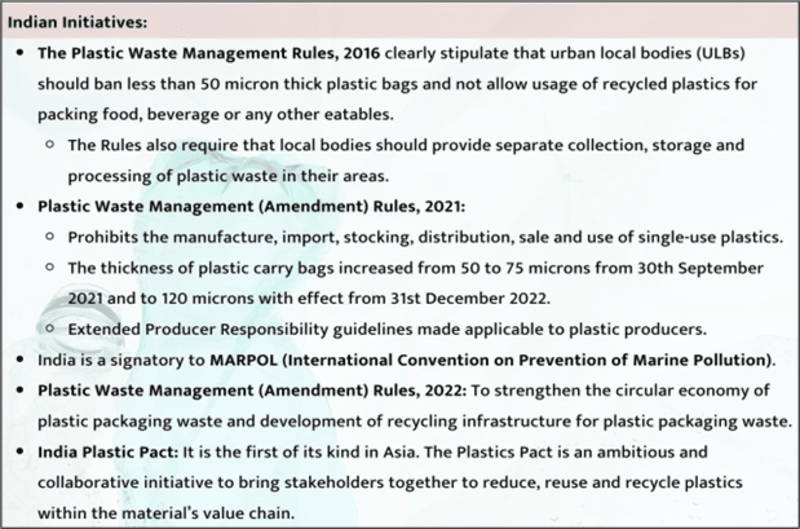
Way Forward
- The approach needs to be changed: Adopting a circular economy approach for tackling the problem of plastic pollution can be helpful. Circular economy solutions can reduce pollution by 80% by 2040. Implement effective segregation systems, establish recycling centres, and promote the adoption of advanced technologies for plastic waste processing.
- Investing in waste-to-energy plants using advanced technologies can reduce fossil fuel dependence and generate electricity while effectively managing plastic waste.
- Enhancing the participation: Financial mechanisms and local capacity-building at the grassroots level are essential for participation and national legislation implementation. This can involve collaboration between the government, private sector, and civil society to develop innovative solutions.
- Ensure Accountability: Governments and businesses must be held accountable through mandatory disclosure and reporting. Major contributors to plastic pollution must be held accountable for supporting infrastructure development in importing countries by at least the volume they export annually.
- Strengthen Waste Management Infrastructure: Financial support is required to invest in robust waste collection and recycling infrastructure across cities and towns.
PYQ
Q1. Enumerate the National Water Policy of India. Taking river Ganges as an example, discuss the strategies which may be adopted for river water pollution control and management. What are the legal provisions of management and handling of hazardous wastes in India? (200 words) (2013)
“One Nation, One Student ID” Initiative – APAAR ID
Relevance: GS II (Social Justice and Governance)
Context
A number of state governments asked schools to get permission from parents in order to create a new student identity card called the Automated Permanent Academic Account Registry (APAAR).
Background
- The APAAR is intended to serve as a unique ID system for all Indian students.
- It is a part of the "One Nation, One Student ID" program, which is founded on the National Education Policy 2020.
- National Education Policy (NEP) 2020 - The new National Education Policy is based on the pillars of Access, Equity, Quality, Affordability, and Accountability. It aims to make both school and college education more holistic, multidisciplinary, and flexible.

Need of APAAR:
- Currently, students have to carry several tangible academic documents with them.
- The state governments are unable to monitor dropout and literacy rates among other metrics, hindering the necessary educational reforms.
- Educational establishments frequently face issues like fraud and duplications of certifications due to the lack of a single, reliable source of academic achievements of students.

Significance of APAAR ID:
- The APAAR ID card serves as a permanent identifying number for students, making monitoring their academic progress and accomplishments simple. Academic data, including degrees, awards, scholarships, and other student credits, would be digitally centrally located.
- Students of all ages will have their academic records tracked by the APAAR number, including those from school, degree colleges, junior colleges, and post-graduation. The Academic Bank of Credit will be connected to the APAAR ID.
- APAAR ID can help monitor student dropout rates and aid in the government's attempts to reintegrate these individuals into the community and reengage them in educational pursuits. Students can immediately get government scheme benefits from the government.
- Transferring students across schools would be more straightforward since it would include all student academic information and is transferable to all Indian colleges.
Concerns regarding APAAR ID
- Sharing Aadhar details raises worries among parents and students who fear that third parties may obtain their personal information.
- A student database, known as the Unified District Information System for Education (UDISE) database, already exists. There is still an unclarity with the requirement of new APAAR ID cards.
- Schools worry about the extra non-academic work, and many have questioned why there isn't a way to refuse consent.
- Educational institutions and employment agencies are included in the list of institutions to which the data obtained through this ID will be made available.
Way forward:
- The Ministry of Education should guarantee that all of the data on it is safe and won't be abused. The sole intended use for this data is educational. Credits are the only thing first-party providers may provide to the system when they verify users to ensure validity.
- Information shared by students should be kept confidential and should not be shared with any third party except for entities engaged in educational activities, such as the Unified District Information System for Education Plus or the UDISE+ database.
- At any given time, students should have the option to stop sharing their information with the mentioned parties, and their data processing to be halted.

UN Report Warns India Heading Towards Groundwater Depletion Tipping Point
GS Paper I, III
Context
Recently, a report has been published by the UN that warns India heading towards the groundwater-depletion tipping point.
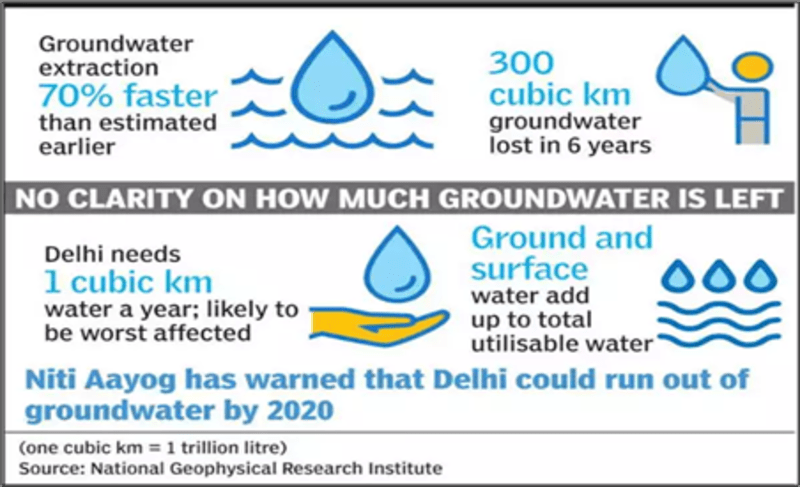
About the news
- The report titled Interconnected Disaster Risks Report 2023 by the United Nations warns that some areas in the Indo-Gangetic basin in India have already reached the tipping point of groundwater depletion.
- It also highlights that the entire northwestern region is expected to face critically low groundwater availability by 2025.
- Also, the world is approaching six environmental tipping points, including groundwater depletion, which can lead to irreversible changes in ecosystems and climate patterns.
- Environmental tipping points are crucial thresholds beyond which sudden and sometimes irreversible changes take place in Earth's systems, resulting in significant and occasionally disastrous changes to ecosystems, climate patterns, and the environment as a whole.
- Six environmental tipping points - Accelerating extinctions, groundwater depletion, mountain glacier melting, space debris, unbearable heat and an uninsurable future.
- The report is published by the United Nations University - Institute for Environment and Human Security (UNU-EHS).
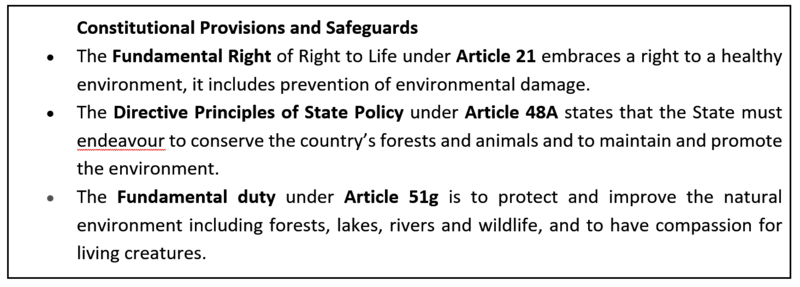
Need to preserve groundwater
- More than 60% of irrigated agriculture and 85% of drinking water supplies are dependent on groundwater.
- Urban residents increasingly rely on groundwater due to unreliable and inadequate municipal water supplies.
- Groundwater acts as a critical buffer against the variability of monsoon rains. For example, a rainfall deficit in 1963-66 decreased India’s food production by 20% but a similar drought in 1987-88 had a very small impact on food production largely due to the widespread use of groundwater by that time.
- Farms irrigated with groundwater have twice the crop water productivity of those that rely on surface water alone.
Conditions of Groundwater and Aquifers
- Around 70% of groundwater withdrawals are used for agriculture, often when above-ground water sources are insufficient.
- Aquifers play a crucial role in mitigating agricultural losses caused by drought, a challenge expected to worsen due to climate change.
- More than half of the world's major aquifers are depleting faster than they can naturally replenish.
- It has been found that 27 of the world’s 31 major aquifers are depleting faster than they can be replenished.
- This will create a negative impact as when the water table falls below a level accessible by existing wells, farmers may lose access to water, posing a risk to entire food production systems.
- Some countries, like Saudi Arabia, have already exceeded the groundwater risk tipping point, while others, including India, are not far from it.
Findings related to India
- India is the world's largest user of groundwater, exceeding the use of the United States and China
- The northwestern region of India serves as the breadbasket for the nation's growing 1.4 billion people, with the states of Punjab and Haryana producing 50% of the country's rice supply and 85% of its wheat stocks.
- 78% of wells in Punjab are considered overexploited and the northwestern region as a whole is predicted to experience critically low groundwater availability by 2025.
Impacts of groundwater depletion
- Lowering of the Water Table: Wells may lose their ability to access groundwater as a result of excessive pumping, which also lowers the groundwater table.
- Increased Costs: More energy is required to pump the water farther to the surface when the water table drops. The expense of using such a well may be prohibitive in severe circumstances.
- Reduced Surface Water Supplies: Surface water and groundwater are intertwined. The lakes, streams, and rivers that are connected to groundwater may see a reduction in supply if groundwater is overused.
- Land Subsidence: When there is a lack of support below the earth, land subsidence happens. The most common cause of this is human activity, mostly from excessive groundwater consumption, which results in the collapse, compaction, and dropping of soil.
- Water Quality Concerns: Saltwater can travel inland and upward as a result of excessive pumping in coastal regions, contaminating the water supply.
Way forward
Groundwater preservation is a difficult and continuous process that calls for a variety of tactics as well as proactive participation by groups, governments, and communities. The aim should be to ensure that this priceless resource is available for upcoming generations.
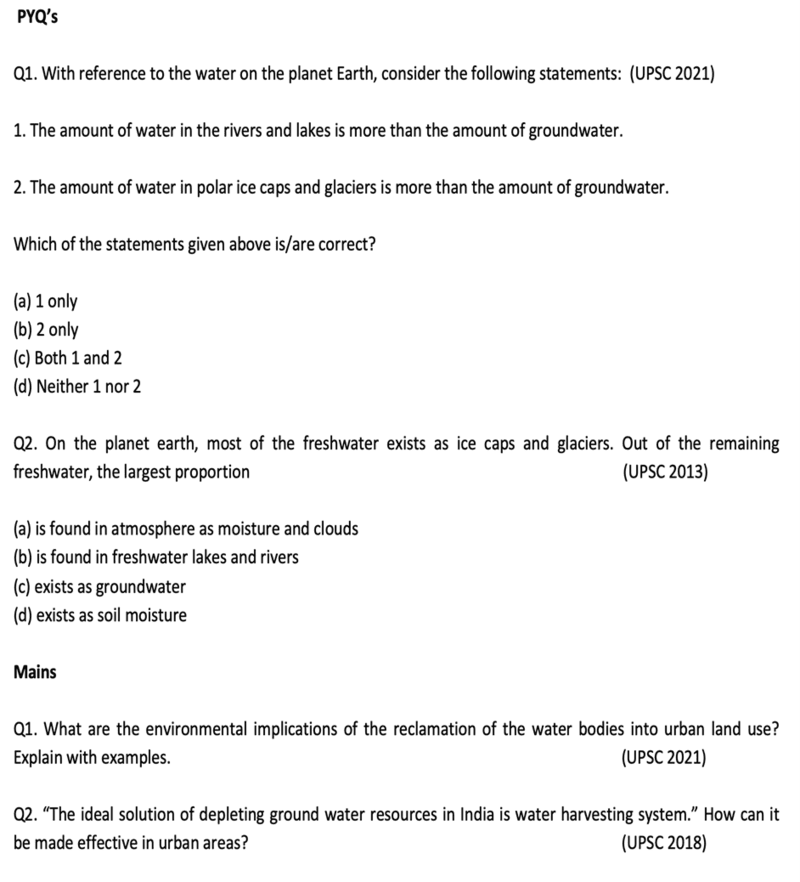
Also in News
“Calixcoca” Vaccine
Context
Researchers in Brazil have created a vaccine "Calixcoca" as a new cure for cocaine and crack.
Working of the Vaccine:
- It triggers an immune response that blocks the high from cocaine and its derivatives and stops it from reaching the brain.
- The immune response trigger will make a patient's body produce antibodies that bind cocaine molecules to the bloodstream.
- The enlarged molecules will be rendered too large to pass into the brain's "reward centre" or the mesolimbic system that is stimulated by cocaine to produce dopamine - the pleasure-inducing reward chemical.
- Once vaccinated, the drug will potentially help people break the cycle of addiction.
Efficiency of the Vaccine:
- The vaccine has produced significant antibodies against cocaine in animal tests conducted by scientists, which have shown encouraging results.
- In addition to having few side effects, the vaccine helped shield rat fetuses against cocaine.
- As per scientists, it would help prevent unborn babies of addicted people.
- After promising results in animals, the vaccine is now set to enter the next stage of trials on humans.
The global challenge of cocaine addiction:
- According to recent statistics, there are approximately 20 million regular cocaine or crack cocaine users worldwide, with one in four developing addiction or use disorders.
- Despite the alarming rise in cocaine and crack addiction, no approved medications are specifically for treating this problem.
- Current treatments often involve a combination of psychiatric, psychological, and social care support.

China's Shenzhou-17 Mission
Context
China has launched its youngest-ever crew of astronauts to the Tiangong space station, marking a significant advancement in the country's space ambitions for the future.
- It was launched from the Jiuquan Satellite Launch Center on the edge of the Gobi Desert in northwestern China atop a Long March 2-F rocket.
About the Mission:
- The Shenzhou-17 crew will take over from the Shenzhou-16 crew which has completed all its tasks.
- Carrying three Chinese astronauts, it is the second manned spacecraft launched by China this year after the Shenzhou-16 manned spacecraft.
- The astronauts will live aboard the orbiting lab for the next six months, performing a variety of scientific experiments and maintenance tasks.
- The new crew will conduct experiments in space medicine, space technology, and other areas during their mission.
- A new telescope will be sent to probe deep into the universe and would enable surveys and mapping of the sky.
Tiangong space station:
- It orbits Earth at an altitude between 217 and 280 miles (340 to 450 kilometres), approximately the same orbital height as the International Space Station (ISS).
- Chinese Manned Space Agency (CMSA) launched each of the three modules that make up the station between 2021 and 2022.
- The CMSA launched Tianhe, the first station module, in April 2021, the second module Wentian in July 2022, and the third module Mengtian in Oct 2022.
- China has announced its plan to expand it, “with the next module slated to dock with the current T-shaped space station to create a cross-shaped structure”.
- The Chinese space station is much smaller than the International Space Station with only three modules, compared with 16 modules on the ISS, which has hosted astronaut crews continuously since November 2000.
- China was excluded from the ISS (International Space Station) program, largely due to U.S. concerns over the Chinese space programs' links with the People's Liberation Army, the military branch of the ruling Communist Party.
